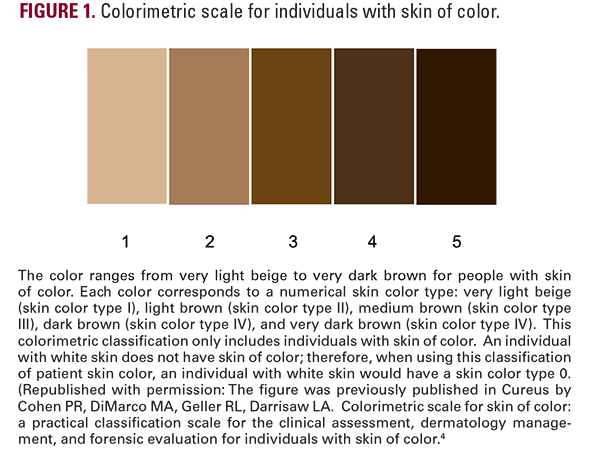To the Editor:
In their excellent report on inverse eruptive syringoma, Wang et al (July 2024 issue)1 state that "this case underscores the importance of recognizing diverse presentations of skin conditions in patients with skin of color and adds to… emphasize this…manifestation…in an individual with darker skin to promote awareness and improve diagnosis and patient outcomes."1 In the first sentence of the case description, the authors present "a 20-year-old African American female (Fitzpatrick skin type V).1" However, the categorization of skin conditions based on the Fitzpatrick scale is suboptimal for adequately classifying patients with skin of color.2
The Fitzpatrick classification of sun-reactive skin types was originally developed for a psoriasis study to determine the initial ultraviolet A dose; it was never intended to be used to categorize patients with skin of color. Fitzpatrick developed the classification in 1975 and added the latter two skin types the following year. Using Fitzpatrick's classification, the skin color of a patient with either type I to IV is white skin, type V has brown skin, and type VI has black skin.2
The lack of an objective scoring system to categorize patients with skin of color has been recognized to be a key contributing factor to the persistence of racial disparities in dermatology.3 A colorimetric scale for skin of color has recently been established (Figure 1). The scale ranges from very light beige to very dark brown.
This new scale would be effective "to promote awareness and improve diagnosis and clinical outcomes in the skin of color patients."1 In addition, this scale provides an opportunity to eliminate racial disparities in dermatology for patients with skin of color and should be incorporated when categorizing skin conditions in these individuals.3 In summary, the colorimetric scale provides a simple approach for clinicians to rapidly categorize patients with skin of color for dermatology management.4
In their excellent report on inverse eruptive syringoma, Wang et al (July 2024 issue)1 state that "this case underscores the importance of recognizing diverse presentations of skin conditions in patients with skin of color and adds to… emphasize this…manifestation…in an individual with darker skin to promote awareness and improve diagnosis and patient outcomes."1 In the first sentence of the case description, the authors present "a 20-year-old African American female (Fitzpatrick skin type V).1" However, the categorization of skin conditions based on the Fitzpatrick scale is suboptimal for adequately classifying patients with skin of color.2
The Fitzpatrick classification of sun-reactive skin types was originally developed for a psoriasis study to determine the initial ultraviolet A dose; it was never intended to be used to categorize patients with skin of color. Fitzpatrick developed the classification in 1975 and added the latter two skin types the following year. Using Fitzpatrick's classification, the skin color of a patient with either type I to IV is white skin, type V has brown skin, and type VI has black skin.2
The lack of an objective scoring system to categorize patients with skin of color has been recognized to be a key contributing factor to the persistence of racial disparities in dermatology.3 A colorimetric scale for skin of color has recently been established (Figure 1). The scale ranges from very light beige to very dark brown.
This new scale would be effective "to promote awareness and improve diagnosis and clinical outcomes in the skin of color patients."1 In addition, this scale provides an opportunity to eliminate racial disparities in dermatology for patients with skin of color and should be incorporated when categorizing skin conditions in these individuals.3 In summary, the colorimetric scale provides a simple approach for clinicians to rapidly categorize patients with skin of color for dermatology management.4

DISCLOSURES
The author has no conflict of interest to disclose.
REFERENCES
- Wang J, Yousefin, Heilman E, Jagdeo J. Inverse eruptive syringoma in a skin of color patient. J Drug Dermatol. 2024;23:564-566.
- Fitzpatrick TB. The validity and practicality of sun-reactive skin types I through VI. Arch Dermatol. 1988;124:869-871.
- Cohen PR, DiMarco MA, Geller RL, Darrisaw LA. Comments on: racial disparities in dermatology. Arch Dermatol Res. 2023;316:48.
- Cohen PR, DiMarco MA, Geller RL, Darrisaw LA. Colorimetric scale for skin of color: a practical classification scale for the clinical assessment, dermatology management, and forensic evaluation for individuals with skin of color. Cureus. 2023;15:e48132.
REFERENCES
REFERENCES
AUTHOR CORRESPONDENCE
Philip R. Cohen MD mitehead@gmail.com






